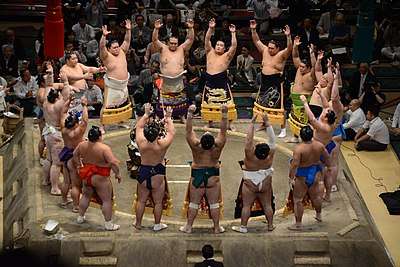Sumo
Sumo (Japanese: 相撲, Hepburn: sumō, [sɯmoː], lit. "striking one another")[1] is a form of competitive full-contact wrestling where a rikishi (wrestler) attempts to force his opponent out of a circular ring (dohyō) or into touching the ground with any body part other than the soles of his feet (usually by throwing, shoving or pushing him down).
A sumo match (tori-kumi) between yokozuna Asashōryū (left) and komusubi Kotoshōgiku in January 2008. | |
| Focus | Grappling |
|---|---|
| Hardness | Full contact |
| Country of origin | Japan |
| Ancestor arts | Tegoi |
| Descendant arts | Jujutsu |
| Olympic sport | No, but IOC recognized |
| Official website | www |
| Highest governing body | International Sumo Federation (Amateur) Japan Sumo Association (Professional) |
|---|---|
| First played | Japan, mid-16th century |
| Characteristics | |
| Contact | Yes |
| Team members | No |
| Mixed gender | Yes (Amateur, separate divisions) No (Professional, men only) |
| Type | Grappling sport |
| Equipment | Mawashi |
| Venue | Dohyō |
| Glossary | Glossary of sumo terms |
| Presence | |
| Country or region | Worldwide (Amateur) Japan (Professional) |
| Olympic | No |
| Paralympic | No |
| World Games | 2001 (invitational) 2005–Present |
| Sumo | |||||
|---|---|---|---|---|---|
"Sumo" in kanji | |||||
| Japanese name | |||||
| Kanji | 相撲 | ||||
| |||||
Sumo originated in Japan, the only country where it is practiced professionally, where it is considered the national sport.[2] It is considered a gendai budō, which refers to modern Japanese martial arts, but the sport has a history spanning many centuries. Many ancient traditions have been preserved in sumo, and even today the sport includes many ritual elements, such as the use of salt purification, from Shinto.
Life as a wrestler is highly regimented, with rules regulated by the Japan Sumo Association. Most sumo wrestlers are required to live in communal sumo training stables, known in Japanese as heya, where all aspects of their daily lives—from meals to their manner of dress—are dictated by strict tradition.
From 2008 to 2016, a number of high-profile controversies and scandals rocked the sumo world, with an associated effect on its reputation and ticket sales. These have also affected the sport's ability to attract recruits.[3] Despite this setback, sumo's popularity and general attendance has rebounded due to having multiple yokozuna (or grand champions) for the first time in a number of years and other high-profile wrestlers such as Endō and Ichinojō grabbing the public's attention.[4]
History
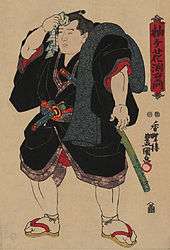
Antiquity (pre-1185)
Prehistoric wall paintings indicate that sumo originated from an agricultural ritual dance performed in prayer for a good harvest.[5] The first mention of sumo can be found in a Kojiki manuscript dating back to 712, which describes how possession of the Japanese islands was decided in a wrestling match between the kami Takemikazuchi and Takeminakata. Takemikazuchi was the ruler of the common people and Takeminakata was the god of wind, water and agriculture. Takeminakata challenged Takemikazuchi for his land. Takemikazuchi had a grip on Takeminakata's arm and crushed it "like a reed," defeating Takeminakata and claiming his land for his gods.[6]
The Nihon Shoki, published in 720, dates the first sumo match between mortals to the year 23 BC, when a man named Nomi no Sukune fought against Taima no Kuehaya at the request of Emperor Suinin and eventually killed him, making him the mythological ancestor of sumo.[5][7] According to The Nihon Shoki, Nomi broke a rib of Taima with one kick, and killed him with a kick to the back as well.[8]Until the Japanese Middle Ages, this unregulated form of wrestling was often fought to the death of one of the fighters.[5] The first historically-attested sumo fights were held in 642 at the court of Empress Kōgyoku to entertain a Korean legation. In the centuries that followed, the popularity of sumo within the court increased its ceremonial and religious significance. Regular events at the Emperor's court, the sumai no sechie, and the establishment of the first set of rules for sumo fall into the cultural heyday of the Heian period.
Japanese Middle Ages (1185–1603)
With the collapse of the Emperor's central authority, sumo lost its importance in the court; during the Kamakura period, sumo was repurposed from a ceremonial struggle to a form of military combat training among samurai.[5][7] By the Muromachi period, sumo had fully left the seclusion of the court and became a popular event for the masses, and among the daimyō it became common to sponsor wrestlers. Sumotori who successfully fought for a daimyō's favor were given generous support and samurai status. Oda Nobunaga, a particularly avid fan of the sport, held a tournament of 1,500 wrestlers in February 1578. Because several bouts were to be held simultaneously within Nobunaga's castle, circular arenas were delimited to hasten the proceedings and to maintain the safety of the spectators. This event marks the invention of the dohyō, which would be developed into its current form up until the 18th century.[5] The winner of Nobunaga's tournament was given a bow for being victorious and he began dancing to show the war-lord his gratitude.[9]
Edo period (1603–1867)
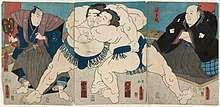
Because sumo had become a nuisance due to wild fighting on the streets, particularly in Edo, sumo was temporarily banned in the city during the Edo period. In 1684, sumo was permitted to be held for charity events on the property of Shinto shrines, as was common in Kyoto and Osaka. The first sanctioned tournament took place in the Tomioka Hachiman Shrine at this time. An official sumo organization was developed, consisting of professional wrestlers at the disposal of the Edo administration. Many elements date from this period, such as the dohyō-iri, the heya system, the gyōji and the mawashi. The 18th century brought forth several notable wrestlers such as Raiden Tameemon, Onogawa Kisaburō and Tanikaze Kajinosuke, the first historical yokozuna.
Since 1868
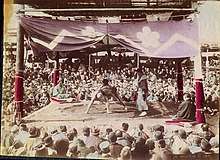
The Meiji Restoration of 1868 brought about the end of the feudal system, and with it the wealthy daimyō as sponsors. Due to a new fixation on Western culture, sumo had come to be seen as an embarrassing and backward relic, and internal disputes split the central association. The popularity of sumo was restored when Emperor Meiji organized a tournament in 1884; his example would make sumo a national symbol and contribute to nationalist sentiment following military successes against Korea and China. The Japan Sumo Association reunited on 28 December 1925 and increased the number of annual tournaments from two to four, and then to six in 1958. The length of tournaments was extended from ten to fifteen days in 1949.[10]
Winning a sumo bout
The winner of a sumo bout is generally either the first wrestler to force his opponent to step out of the ring, or the first wrestler to force his opponent to touch the ground with any part of his body other than the bottom of his feet.[11] Also, a number of other less common rules can be used to determine the winner. For example, a wrestler using an illegal technique (kinjite) automatically loses, as does one whose mawashi (belt) comes completely undone. A wrestler failing to show up for his bout (even if due to prior injury) also automatically loses (fusenpai).
The initial crouch and charge are crucial. Upon positioning themselves opposite each other, the wrestlers perform a deep squat; without taking their feet off the ground, they then move forwards into a head-first crouched position, whilst also resting on one or two fists. This position is important because it allows them to adopt a more efficient posture to charge from and also isometrically preloads their muscles: this enables them to spring up and charge their opponents more powerfully when the referee signals the bout to begin. A successful charge is usually a powerful charge and is often a key determining factor in who wins the bout.
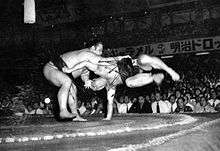
Bouts consist solely of a single round and often last only a few seconds, as usually one wrestler is quickly ousted from the circle or thrown to the ground. However, they can occasionally last for several minutes. Each match is preceded by an elaborate ceremonial ritual. Traditionally, sumo wrestlers are renowned for their great girth and body mass, which is often a winning factor in sumo. No weight divisions are used in professional sumo; a wrestler can sometimes face an opponent twice his own weight. However, with superior technique, smaller wrestlers can control and defeat much larger opponents.[12] The average weight of top division wrestlers has continued to increase, from 125 kilograms (276 lb) in 1969 to over 150 kilograms (330 lb) by 1991, and was a record 166 kilograms (366 lb) as of January 2019.[13]
In some situations, a review of the gyōji's decision may be needed. The judges outside the ring, who sit at eye level (the shimpan) may convene a conference in the middle of the ring, called a mono-ii. This is done if the judges decide that the decision over who won the bout needs to be reviewed; for example, if both sumotori appear to touch the ground or step out of the ring at the same time. In these cases, sometimes video is reviewed to see what happened. Once a decision is made, the chief judge will announce the decision to the spectators and the wrestlers alike. They may order a bout to be restarted, or leave the decision as given by the gyōji. Occasionally the shimpan will overrule the gyōji and give the bout to the other wrestler.
After the winner is declared, an off-stage gyōji (referee) determines the kimarite (or winning technique) used in the bout, which is then announced to the audience. The Japan Sumo Association recognizes 82 different kimarite and 5 different hiwaza (or non-technique) in a win.[14]
On rare occasions the referee or judges may award the win to the wrestler who touched the ground first. This happens if both wrestlers touch the ground at nearly the same time and it is decided that the wrestler who touched the ground second had no chance of winning, his opponent's superior sumo having put him in an irrecoverable position. The losing wrestler is referred to as being shini-tai ("dead body") in this case.
Wrestling ring (dohyō)
Sumo matches take place in a dohyō[15] (土俵): a ring, 4.55 m (14.9 ft) in diameter and 16.26 m2 (175.0 sq ft) in area, of rice-straw bales on top of a platform made of clay mixed with sand. A new dohyō is built for each tournament by the bout callers (or yobidashi). At the center are two white lines, the shikiri-sen, behind which the wrestlers position themselves at the start of the bout.[16] A roof resembling that of a Shinto shrine may be suspended over the dohyō. Women are traditionally forbidden from entering or touching the ring.[17]
Professional sumo
Professional sumo is organized by the Japan Sumo Association.[18] The members of the association, called oyakata, are all former wrestlers, and are the only people entitled to train new wrestlers. Most practicing wrestlers are members of a training stable (or heya) run by one of the oyakata, who is the stablemaster for the wrestlers under him. In 2007, 43 training stables hosted 660 wrestlers.[19]
All sumo wrestlers take wrestling names called shikona (四股名), which may or may not be related to their real names. Often, wrestlers have little choice in their names, which are given to them by their trainers (or stablemasters), or by a supporter or family member who encouraged them into the sport. This is particularly true of foreign-born wrestlers. A wrestler may change his wrestling name during his career, with some wrestlers changing theirs several times.[18]
Sumo wrestling is a strict hierarchy based on sporting merit. The wrestlers are ranked according to a system that dates back to the Edo period. Wrestlers are promoted or demoted according to their performance in six official tournaments held throughout the year. A carefully prepared banzuke listing the full hierarchy is published two weeks prior to each sumo tournament.[20]
In addition to the professional tournaments, exhibition competitions are held at regular intervals every year in Japan, and roughly once every two years, the top-ranked wrestlers visit a foreign country for such exhibitions. None of these displays is taken into account in determining a wrestler's future rank. Rank is determined only by performance in grand sumo tournaments (or honbasho).[16]
Sumo divisions

The six divisions in sumo, in descending order of prestige, are:
- makuuchi (幕内). Maximum 42 wrestlers; Further divided into five ranks
- jūryō (十両). Fixed at 28 wrestlers
- makushita (幕下). Fixed at 120 wrestlers
- sandanme (三段目). Fixed at 200 wrestlers
- jonidan (序二段). About 200 wrestlers
- jonokuchi (序ノ口 or 序の口). Around 50 wrestlers
Wrestlers enter sumo in the lowest jonokuchi division and, ability permitting, work their way up to the top division. A broad demarcation in the sumo world can be seen between the wrestlers in the top two divisions known as sekitori (関取) and those in the four lower divisions, known commonly by the more generic term rikishi (力士). The ranks receive different levels of compensation, privileges, and status.[21]
The topmost makuuchi division receives the most attention from fans and has the most complex hierarchy. The majority of wrestlers are maegashira (前頭) and are ranked from the highest level 1 down to about 16 or 17. In each rank are two wrestlers, the higher rank is designated as "east" and the lower as "west", so the list goes #1 east, #1 west, #2 east, #2 west, etc.[22] Above the maegashira are the three champion or titleholder ranks, called the san'yaku, which are not numbered. These are, in ascending order, komusubi (小結), sekiwake (関脇), and ōzeki (大関). At the pinnacle of the ranking system is the rank of yokozuna (横綱).[21]
Yokozuna, or grand champions, are generally expected to compete for and to win the top division tournament title on a regular basis, hence the promotion criteria for yokozuna are very strict. In general, an ōzeki must win the championship for two consecutive tournaments or an "equivalent performance" to be considered for promotion to yokozuna.[18] More than one wrestler can hold the rank of yokozuna at the same time.
In antiquity, sumo was solely a Japanese sport. Since the 1900s, however, the number of foreign-born sumo wrestlers has gradually increased. In the beginning of this period, these few foreign wrestlers were listed as Japanese, but particularly since the 1960s, a number of high-profile foreign-born wrestlers became well-known, and in more recent years have even come to dominate in the highest ranks. In the 10 years since January 2009, five of the nine wrestlers promoted to ōzeki, have been foreign-born[23], and a Japanese had not been named yokozuna from 1998 until the promotion of Kisenosato Yutaka in 2017. This and other issues eventually led the Sumo Association to limit the number of foreigners allowed to one in each stable.
Professional sumo tournaments
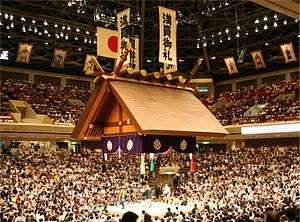
Since 1958, six Grand Sumo tournaments (Japanese: honbasho) have been held each year: three at the Sumo Hall (or Ryōgoku Kokugikan) in Ryōgoku, Tokyo (January, May, and September), and one each in Osaka (March), Nagoya (July), and Fukuoka (November). Each tournament begins on a Sunday and runs for 15 days, ending also on a Sunday.[26] The tournaments are organized in a manner akin to a McMahon system tournament; each wrestler in the top two divisions (sekitori) has one match per day, while the lower-ranked wrestlers compete in seven bouts, about one every two days.
Each day is structured so that the highest-ranked contestants compete at the end of the day. Thus, wrestling starts in the morning with the jonokuchi wrestlers and ends at around six o'clock in the evening with bouts involving the yokozuna. The wrestler who wins the most matches over the 15 days wins the tournament championship (yūshō) for his division. If two wrestlers are tied for the top, they wrestle each other and the winner takes the title. Three-way ties for a championship are rare, at least in the top division. In these cases, the three wrestle each other in pairs with the first to win two in a row take the tournament. More complex systems for championship playoffs involving four or more wrestlers also exist, but these are usually only seen in determining the winner of one of the lower divisions.

The matchups for each day of the tournament are announced a day in advance. They are determined by the sumo elders who are members of the judging division of the Sumo Association. As many more wrestlers are in each division than matchups during the tournament, each wrestler only competes against a selection of opponents from the same division, though small overlaps can occur between two divisions. With the exception of the san'yaku-ranked wrestlers, the first bouts tend to be between wrestlers who are within a few ranks of each other. Afterwards, the selection of opponents takes into account a wrestler's prior performance. For example, in the lower divisions, wrestlers with the same record in a tournament are generally matched up with each other and the last matchups often involve undefeated wrestlers competing against each other, even if they are from opposite ends of the division. In the top division, in the last few days, wrestlers with exceptional records often have matches against much more highly ranked opponents, including san'yaku wrestlers, especially if they are still in the running for the top division championship. Similarly, more highly ranked wrestlers with very poor records may find themselves fighting wrestlers much further down the division. For the yokozuna and ōzeki, the first week and a half of the tournament tends to be taken up with bouts against the top maegashira, komusubi, and sekiwake, with the bouts within these ranks being concentrated into the last five days or so of the tournament (depending on the number of top-ranked wrestlers competing). Traditionally, on the final day, the last three bouts of the tournament are between the top six ranked wrestlers, with the top two competing in the final matchup, unless injuries during the tournament prevent this.
Certain match-ups are prohibited in regular tournament play. Wrestlers who are from the same training stable cannot compete against each other, nor can wrestlers who are brothers, even if they join different stables. The one exception to this rule is that training stable partners and brothers can face each other in a championship-deciding playoff match.
The last day of the tournament is called senshūraku, which literally means "the pleasure of a thousand autumns". This colorful name for the culmination of the tournament echoes the words of the playwright Zeami to represent the excitement of the decisive bouts and the celebration of the victor. The Emperor's Cup is presented to the wrestler who wins the top-division makuuchi championship. Numerous other (mostly sponsored) prizes are also awarded to him. These prizes are often rather elaborate, ornate gifts, such as giant cups, decorative plates, and statuettes. Others are quite commercial, such as one trophy shaped like a giant Coca-Cola bottle.
Promotion and relegation for the next tournament are determined by a wrestler's score over the 15 days. In the top division, the term kachikoshi means a score of 8–7 or better, as opposed to makekoshi, which indicates a score of 7–8 or worse. A wrestler who achieves kachikoshi almost always is promoted further up the ladder, the level of promotion being higher for better scores. See the makuuchi article for more details on promotion and relegation.
A top-division wrestler who is not an ōzeki or yokozuna and who finishes the tournament with kachikoshi is also eligible to be considered for one of the three prizes awarded for "technique", "fighting spirit", and defeating the most yokozuna and ōzeki the "outstanding performance" prize. For more information see sanshō.
For the list of upper divisions champions since 1909, refer to the list of top division champions and the list of second division champions.
A professional sumo bout
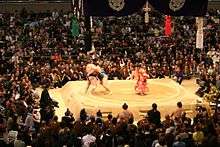
At the initial charge, both wrestlers must jump up from the crouch simultaneously after touching the surface of the ring with two fists at the start of the bout. The referee (gyōji) can restart the bout if this simultaneous touch does not occur. Upon completion of the bout, the referee must immediately designate his decision by pointing his gunbai or war-fan towards the winning side. The winning technique (kimarite) used by the winner would then be announced to the audience. The referee's decision is not final and may be disputed by the five judges seated around the ring. If this happens, they meet in the center of the ring to hold a mono-ii (a talk about things). After reaching a consensus, they can uphold or reverse the referee's decision or order a rematch, known as a torinaoshi. The wrestlers then return to their starting positions and bow to each other before retiring. A winning wrestler in the top division may receive additional prize money in envelopes from the referee if the matchup has been sponsored. If a yokozuna is defeated by a lower-ranked wrestler, it is common and expected for audience members to throw their seat cushions into the ring (and onto the wrestlers), though this practice is technically prohibited.
In contrast to the time in bout preparation, bouts are typically very short, usually less than a minute (most of the time only a few seconds). Extremely rarely, a bout can go on for several minutes. If a bout lasts up to four minutes, the referee or one of the judges sitting around the ring may call a mizu-iri or "water break". The wrestlers are carefully separated, have a brief break, and then return to the exact position they left, as determined by the referee. If after four more minutes, they are still deadlocked, they may have a second break, after which they start from the beginning. Further deadlock with no end of the bout in sight can lead to a draw (hikiwake), an extremely rare result in modern sumo. The last draw in the top division was in September 1974.[18]
Life as a professional sumo wrestler
A sumo wrestler leads a highly regimented way of life. The Sumo Association prescribes the behavior of its wrestlers in some detail. For example, the association prohibits wrestlers from driving cars, although this is partly out of necessity as many wrestlers are too big to fit behind a steering wheel.[27] Breaking the rules can result in fines and/or suspension for both the offending wrestler and his stablemaster.
On entering sumo, they are expected to grow their hair long to form a topknot, or chonmage, similar to the samurai hairstyles of the Edo period. Furthermore, they are expected to wear the chonmage and traditional Japanese dress when in public, allowing them to be identified immediately as wrestlers.
The type and quality of the dress depends on the wrestler's rank. Rikishi in jonidan and below are allowed to wear only a thin cotton robe called a yukata, even in winter. Furthermore, when outside, they must wear a form of wooden sandal called geta. Wrestlers in the makushita and sandanme divisions can wear a form of traditional short overcoat over their yukata and are allowed to wear straw sandals, called zōri. The higher-ranked sekitori can wear silk robes of their own choice, and the quality of the garb is significantly improved. They also are expected to wear a more elaborate form of topknot called an ōichō (big ginkgo leaf) on formal occasions.
Similar distinctions are made in stable life. The junior wrestlers must get up earliest, around 5 am, for training, whereas the sekitori may start around 7 am. When the sekitori are training, the junior wrestlers may have chores to do, such as assisting in cooking the lunch, cleaning, and preparing the bath, holding a sekitori's towel, or wiping the sweat from him. The ranking hierarchy is preserved for the order of precedence in bathing after training, and in eating lunch.
Wrestlers are not normally allowed to eat breakfast and are expected to have a siesta-like nap after a large lunch. The most common type of lunch served is the traditional sumo meal of chankonabe, which consists of a simmering stew of various fish, meat, and vegetables cooked at the table. It is usually eaten with rice and washed down with beer. This regimen of no breakfast and a large lunch followed by a sleep is intended to help wrestlers put on a lot of weight so as to compete more effectively.
In the afternoon, the junior wrestlers again usually have cleaning or other chores, while their sekitori counterparts may relax, or deal with work issues related to their fan clubs. Younger wrestlers also attend classes, although their education differs from the typical curriculum of their non-sumo peers. In the evening, sekitori may go out with their sponsors, while the junior wrestlers generally stay at home in the stable, unless they are to accompany the stablemaster or a sekitori as his tsukebito (manservant) when he is out. Becoming a tsukebito for a senior member of the stable is a typical duty. A sekitori has a number of tsukebito, depending on the size of the stable or in some cases depending on the size of the sekitori. The junior wrestlers are given the most mundane tasks such as cleaning the stable, running errands, and even washing or massaging the exceptionally large sekitori while only the senior tsukebito accompany the sekitori when he goes out.
The sekitori are given their own room in the stable, or may live in their own apartments, as do married wrestlers; the junior wrestlers sleep in communal dormitories. Thus, the world of the sumo wrestler is split broadly between the junior wrestlers, who serve, and the sekitori, who are served. Life is especially harsh for recruits, to whom the worst jobs tend to be allocated, and the dropout rate at this stage is high.
The negative health effects of the sumo lifestyle can become apparent later in life. Sumo wrestlers have a life expectancy between 60 and 65, more than 10 years shorter than the average Japanese male, as the diet and sport take a toll on the wrestler's body. Many develop type 2 diabetes or high blood pressure, and they are prone to heart attacks due to the enormous amount of body mass and fat that they accumulate. The excessive intake of alcohol can lead to liver problems and the stress on their joints due to their excess weight can cause arthritis. Recently, the standards of weight gain are becoming less strict, in an effort to improve the overall health of the wrestlers.[28][29]
Physical requirements
Some sumo organizations have minimum height and weight requirements for their competitors. In 1994, the Japanese Sumo Association required that all sumo wrestlers be a minimum 173 cm (5 feet 8 inches) in height. This prompted 16-year-old Takeji Harada of Japan (who had failed six previous eligibility tests) to have four separate cosmetic surgeries over a period of 12 months to add an extra 15 cm (6 inches) of silicone to his scalp, which created a large, protruding bulge on his head.[30] In response to this, the JSA stated that they would no longer accept aspiring wrestlers who surgically enhanced their height, citing health concerns.[31] In 2019, The Japan Times reported that the height requirement was 167 cm (5'4"), while the weight requirement was 67 kg (147 lbs). Although, they also claimed that a "blind eye" is turned for those "just shy" of the minimums.[32]
Salary and payment
As of 2018, the monthly salary figures (in Japanese yen) for the top two divisions were:[33]

- yokozuna: ¥3 million, about US$26,500
- ōzeki: ¥2.5 million, about US$22,000
- san'yaku: ¥1.8 million, about US$16,000
- maegashira: ¥1.4 million, about US$12,500
- jūryō: ¥1.1 million, about US$9,500
Wrestlers lower than the second-highest division, who are considered trainees, receive only a fairly small allowance instead of a salary.
In addition to the basic salary, sekitori wrestlers also receive additional bonus income, called mochikyūkin, six times a year (once every tournament, or basho) based on the cumulative performance in their career to date. This bonus increases every time the wrestler scores a kachikoshi (with larger kachikoshi giving larger raises). Special increases in this bonus are also awarded for winning the top division championship (with an extra large increase for a "perfect" championship victory with no losses), and also for scoring a gold star or kinboshi (an upset of a yokozuna by a maegashira).
San'yaku wrestlers also receive a relatively small additional tournament allowance, depending on their rank, and yokozuna receive an additional allowance every second tournament, associated with the making of a new tsuna belt worn in their ring entering ceremony.
Also, prize money is given to the winner of each divisional championship, which increases from ¥100,000 for a jonokuchi victory up to ¥10 million for winning the top division. In addition to prizes for a championship, wrestlers in the top division giving an exceptional performance in the eyes of a judging panel can also receive one or more of three special prizes (the sanshō), which are worth ¥2 million each.[34]
Individual top division matches can also be sponsored by companies. These prizes are called kenshōkin. For bouts involving yokozuna and ōzeki, the number of sponsors can be quite large, whereas for lower-ranked matchups, no bout sponsors may be active at all unless one of the wrestlers is particularly popular, or unless a company has a policy of sponsoring all his matchups. As of 2019, a single sponsorship cost ¥70,000, with ¥60,000 going to the winner of the bout and ¥10,000 deducted by the Japan Sumo Association for costs and fees.[35] Immediately after the match, the winner receives an envelope from the referee with half of his share of the sponsorship, while the other half is put in a fund for his retirement.[35] No prize money is awarded for bouts decided by a fusenshō or forfeit victory.
Amateur sumo
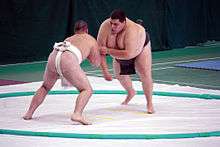
Sumo is also practised as an amateur sport, with participants in college, high school, and grade school in Japan. In addition to college and school tournaments, open amateur tournaments are also held. The sport at this level is stripped of most of the ceremony. The most successful amateur wrestlers in Japan (usually college champions) can be allowed to enter professional sumo at makushita (third division) or sandanme (fourth division) rather than from the very bottom of the ladder. These ranks are called makushita tsukedashi and sandanme tsukedashi, and are currently equivalent to makushita 10, makushita 15, or sandanme 100 depending on the level of amateur success achieved. Many of the current top division wrestlers entered professional sumo by this route. All amateur athletes entering the professional ranks must be under 23 to satisfy the entry, except those who qualify for makushita tsukedashi or sandanme tsukedashi, who may be up to 25.
The International Sumo Federation was established to encourage the sport's development worldwide, including holding international championships. A key aim of the federation is to have sumo recognized as an Olympic sport. Accordingly, amateur tournaments are divided into weight classes (men: Lightweight up to 85 kg (187 lb), Middleweight up to 115 kg (254 lb), Heavyweight over 115 kg (254 lb), and Open Weight (unrestricted entry), and include competitions for female wrestlers (Lightweight up to 65 kg (143 lb), Middleweight up to 80 kg (180 lb), Heavyweight over 80 kg (180 lb), and Open Weight).
Amateur sumo clubs are gaining in popularity in the United States, with competitions regularly being held in major cities across the country. The US Sumo Open, for example, was held in the Los Angeles Convention Center in 2007 with an audience of 3,000.[36] The sport has long been popular on the West Coast and in Hawaii, where it has played a part in the festivals of the Japanese ethnic communities. Now, however, the sport has grown beyond the sphere of Japanese diaspora and athletes come from a variety of ethnic, cultural, and sporting backgrounds.
Amateur sumo is particularly strong in Europe. Many athletes come to the sport from a background in judo, freestyle wrestling, or other grappling sports such as sambo. Some Eastern European athletes have been successful enough to be scouted into professional sumo in Japan, much like their Japanese amateur counterparts. The most notable of these to date is the Bulgarian Kotoōshū, who is the highest-ranking foreign wrestler who was formerly an amateur sumo athlete.
Brazil is another center of amateur sumo, introduced by Japanese immigrants who arrived during the first half of the twentieth century. The first Brazilian sumo tournament was held in 1914.[37] Sumo took root in immigrant centers in southern Brazil, especially São Paulo, which is now home to the only purpose-built sumo training facility outside Japan.[38] Beginning in the 1990s, Brazilian sumo organizations made an effort to interest Brazilians without Japanese ancestry in the sport, and by the mid-2000s an estimated 70% of participants came from outside the Japanese-Brazilian community.[37] Brazil is also a center for women's sumo.[38] A small number of Brazilian wrestlers have made the transition to professional sumo in Japan, including Ryūkō Gō and Kaisei Ichirō.
Clothing
Sumo wrestlers wear Mawashi which is essentially a thick 30-foot-long belt, that they tie in knots in the back.[39] They have an official thickness and strength requirement. During matches, the wrestler will grab onto the other wrestler's Mawashi and use it to help them and make moves during a match.[40] The Mawashi they wear practicing versus in a tournament is essentially the same except for the material. The different Mawashi that the wrestlers wear differentiate their rank. Top rated wrestlers wear different colors of silk Mawashi during tournament, while lower rated wrestlers are limited to just black cotton. Sumo wrestlers wear Mawashi because there are fewer ways to cheat when you wear one.[40]
Their hair is put in what they call a topknot, and they use wax to get it to stay. Wax is applied to sumo wrestlers' hair daily by sumo hairdressers (Tokoyama).[41] The topknot is a type of Samurai hairstyle which was once popular in Japan during the Edo period.[41] The topknot is hard for some foreigner's hair because their hair is not as coarse and straight as Japanese hair. Once a wrestler joins a stable, they are required to grow out their hair in order to form a topknot.[41]
Outside of tournaments and practices, in daily life, sumo wrestlers are required to wear traditional Japanese clothes.[42] They must wear these traditional clothes all the time in public. What you can wear in public is also determined by rank. Lower rated wrestlers must wear a Yukata at all times, even in winter, where higher rated wrestlers have more choice in what they wear.[42]
Image gallery
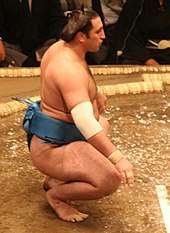 Initial full squat with heels up, Sonkyo (蹲踞) in Japanese.
Initial full squat with heels up, Sonkyo (蹲踞) in Japanese. Partial squat before engaging.
Partial squat before engaging.
See also
- Controversies in professional sumo
- Culture of Japan
- Glossary of sumo terms
- Kimarite, list of winning moves in sumo
- List of active sumo wrestlers
- List of past sumo wrestlers
- List of sumo stables
- List of sumo record holders
- List of sumo tournament top division champions
- List of sumo tournament second division champions
- List of years in sumo
- List of yokozuna
- Lists of sumo wrestlers
- Sumo East and West, documentary on sumo
- Ssireum, traditional Korean wrestling
- Robot-sumo, robot competition inspired by sumo
- Naki Sumo Crying Baby Festival
References
- "Sumo".
- "What Is Sumo?". Kids Web Japan. Ministry of Foreign Affairs. Retrieved May 16, 2020.
- "Decline in apprentices threatens future of national sport". Asahi Shimbun. Archived from the original on June 28, 2013. Retrieved June 23, 2013.
- "Revival of sumo's popularity" (in Japanese). Saga Shinbun. Retrieved December 8, 2014.
- Sharnoff, Lora (August 13, 2013). "History of Sumo". USA Dojo. Retrieved December 29, 2019.
- Blaine Henry (April 14, 2020). "History Lesson: Sumo Wrestling's Ancient Origins". Fight-Library.com.
- Shigeru Takayama. "Encyclopedia of Shinto: Sumō". Kokugakuin University. Retrieved December 29, 2019.
- Blaine Henry (April 14, 2020). "History Lesson: Sumo Wrestling's Ancient Origins". Fight-Library.com.
- Blaine Henry (April 14, 2020). "History Lesson: Sumo Wrestling's Ancient Origins". Fight-Library.com.
- Blaine Henry (April 14, 2020). "History Lesson: Sumo Wrestling's Ancient Origins". Fight-Library.com.
- "Winning a Sumo Bout". Kids Web Japan. Ministry of Foreign Affairs. Retrieved May 16, 2020.
- "Rules of Sumo". Beginner's Guide of Sumo. Japan Sumo Association. Archived from the original on June 1, 2007. Retrieved June 26, 2007.
- "SUMO/ Heavier wrestlers blamed for increase in serious injuries". Asahi Shimbun. February 19, 2019. Retrieved March 8, 2019.
- "Kimarite Menu". Japan Sumo Association. Archived from the original on July 9, 2009. Retrieved January 20, 2010.
- Pathade, Mahesh. "what is Dohyo". Kheliyad. Retrieved March 9, 2020.
- Hall, Mina (1997). The Big Book of Sumo: History, Practice, Ritual, Fight. Stone Bridge Press. ISBN 1-880656-28-0.
- http://www.msn.com/en-us/news/world/female-medics-rushed-to-help-a-man-who-collapsed-on-a-sumo -ring-they-were-promptly-told-to-leave/ar-AAvuhSO?li=BBnb7Kz&ocid=ASUDHP
- Sharnoff, Lora (1993). Grand Sumo. Weatherhill. ISBN 0-8348-0283-X.
- "Sumo Beya Guide". Japan Sumo Association. Archived from the original on July 15, 2007. Retrieved July 8, 2007.
- Kamiya, Setsuko (February 19, 2010). "Steeped in tradition, Shinto, sumo is also scandal-stained". Japan Times. Retrieved August 16, 2017.
- "Banzuke". Beginner's Guide of Sumo. Japan Sumo Association. Archived from the original on June 30, 2007. Retrieved June 27, 2007.
- "Sumo FAQ - Professional rankings: The Banzuke". scgroup.com. Archived from the original on October 1, 2012.
- "SumoDB Ozeki promotion search".
- Yoshida, Reiji (April 30, 2018). "Banning women from the sumo ring: centuries-old tradition, straight-up sexism or something more complex?". The Japan Times. Retrieved December 11, 2019.
- Pathade, Mahesh. "women sumo wrestling restrictions". Kheliyad. Retrieved March 9, 2020.
- An exception to this rule occurred when Hirohito, the former Emperor of Japan, died on Saturday, January 7, 1989. The tournament that was to start on the following day was postponed to start on Monday, January 9 and finish on Monday, January 24.
- Seales, Rebecca (December 1, 2017). "Inside the scandal-hit world of sumo". BBC News. Retrieved October 1, 2018.
- "Becoming a Sumo Wrestler". Sumo East and West. Discovery Channel. Archived from the original on August 31, 2005. Retrieved November 18, 2005.
- "United Nations Statistics Division – Demographic and Social Statistics". Retrieved November 18, 2005.
- Ashmun, Chuck (1994). "Wrestlers Go Great Lengths To Qualify". Seattle Times. Retrieved October 15, 2018.
- "Silicone Raises Sumo Hopeful to New Heights". July 7, 1994 – via LA Times.
- Gunning, John (January 13, 2019). "Sumo 101: Becoming a rikishi". The Japan Times. Retrieved August 13, 2020.
- "Rikishi Salaries" (in Japanese). Retrieved December 3, 2018.
- "Sumo Questions". Retrieved November 18, 2005.
- "秋場所から懸賞金額アップ、手取り変わらず積立金↑" (in Japanese). Nikkan Sports. May 30, 2019. Retrieved July 22, 2020.
- My First Date With Sumo (2007) Gould, Chris Archived September 28, 2012, at the Wayback Machine
- Benson, Todd (January 27, 2005). "Brazil's Japanese Preserve Sumo and Share It With Others". The New York Times. Retrieved November 21, 2016.
- Kwok, Matt (August 2, 2016). "'Sumo feminino': How Brazil's female sumo wrestlers are knocking down gender barriers". CBC News. Retrieved November 21, 2016.
- "Sumo Equipment".
- "What Do Sumo Wrestlers Wear During a Match?". LIVESTRONG.COM. Retrieved October 19, 2019.
- "The Topknot". Sportsrec.
- "Things You Didn't Know About Sumo Wrestlers".
Further reading
- Benjamin, David (1991). The Joy of Sumo: A Fan's Notes. Rutland, Vermont, U.S.A. & Tokyo, Japan: Charles E. Tuttle Company. ISBN 0-8048-1679-4.
- Gould, Chris (2011). Sumo Through the Wrestlers' Eyes. Amazon. ASIN B006C1I5K8.
- Gould, Chris (2011) [2007]. My First Date With Sumo. Amazon. ASIN B0061BMG0O.
- Schilling, Mark (1994). Sumo: A Fan's Guide. Tokyo, Japan: The Japan Times, Ltd. ISBN 4-7890-0725-1.
- Shapiro, David (1995). Sumo: A Pocket Guide. Rutland, Vermont, U.S.A. & Tokyo, Japan: Charles E. Tuttle Company. ISBN 0-8048-2014-7.
- Sharnoff, Lora (1993). Grand Sumo. Weatherhill. ISBN 0-8348-0283-X.
- Tablero, Fco. Javier (2002). Parentesco y organización del sumo en Japón. Madrid: Universidad Complutense de Madrid. ISBN 84-8466-257-8.
External links
| Wikimedia Commons has media related to: |
- Nihon Sumo Kyokai Official Grand Sumo Home Page
- The Sumo Forum
- Live-Stream and Video-on-Demand from Grand Sumo Tournament on NHK Japan (english)
- Sumo FAQ
- Searchable Sumo Database
- Sumo News and Analysis
- A Matter of Size, an Israeli fictional film on Amateur Sumo (2009)
